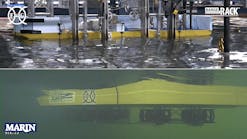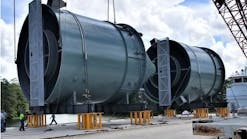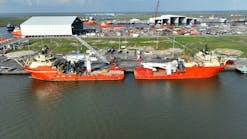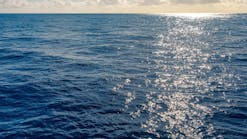Africa
According to Namibia's National Petro-leum Corporation (Namcor), applications for exploration licenses to explore the Namibe Basin, which straddles the border between Namibia and Angola, are sparse. On the basis of Angola's state-owned Sonangol's earlier announcement that there was oil in the Namibe Basin, the two companies invited 165 international oil companies and individuals to apply for exploration licenses. According to Namcor Managing Director Joe Mazeingo, the seminars in London and Houston were attended by a record number of companies (65 in Houston, 100 in London). The lack of interest is not indicative of the profitability of exploration and production in the area. Good oil discoveries have been made in the Congo Basin north of Angola, and gas was discovered in the south of Namibia at the Orange River Basin. At present, only one exploration license is held in the Namibe Basin by a joint venture, comprising Vanco Energy of the US (88%), Namcor (9%), and a local empowerment group, Pamue (3%).
Triton Energy Limited reported another oil discovery on Block G offshore Equatorial Guinea. The Okume-1 well, nine miles northeast of Triton's Ceiba Field, encountered reservoirs similar in quality to those of Ceiba, with an average porosity of 28% and multidarcies of permeability. The Okume-1 discovery is Triton's second major oil discovery on Block G in less than two years.
Triton plans for future appraisal to confirm the discovery and to prove minimum economic reserves. A third discovery on Block G was announced in late June. The Oveng discovery, 3.5 miles east of Okumi-1, is the second major oil discovery on Block G this year.
Vaalco Energy, Inc. announced approval from the Directorate General of Hydrocarbons in Gabon for the creation of a production area surrounding Etame Field in the Etame Block offshore Gabon. The company spudded the Etame 4 well in May to further define the Etame Field, particularly the Gamba and Dentale reservoirs in the north. Together with the Etame 1 and Etame 3 wells, these will provide a foundation for bringing the field into production by early 2002. Commen-surate with the approval of the production area, Vaalco submitted an application to extend the remainder of the Etame Block area for three additional years, beginning October 2001.
Americas
USX-Marathon Group is divesting nearly all of its Canadian oil assets in order to shift focus to gas exploration and production operations in western Canada and offshore Nova Scotia. When the selling concludes, the company will have sold nearly a third of its Canadian production, much of which was acquired around three years ago when Marathon bought Tarragon Oil & Gas Ltd. With this move, Marathon joins a number of major oil companies gearing up for a big gas exploration push offshore Nova Scotia.
Petrobras of Brazil announced it has found a new 8 bcm natural gas reserve off the southeastern state of Espirito Santo in the Bacia do Espirito Santo field. Adding this new field's gas reserves to those already identified doubles the size of Petrobras' gas reserves in the area. At present, Petrobras produces 36 MMcm/d of gas. Brazil has proven reserves of 228.7 bcm of gas.
Europe
Norway Minister of Petroleum and Energy Olav Akselsen officially opened the Åsgard field on the Halten Bank the first week of June, noting "the development of Åsgard signifies the opening of the Norwegian Sea as a new gas province."
The development is made of:
- Åsgard field, an extensive system of wells and pipelines; the oil production vessel Åsgard A; the gas platform Åsgard B; and the storage vessel Åsgard C.
- 707-km Åsgard transport trunkline which links gas producing fields in the Norwegian Sea to Karst north of Stavanger and the consumer markets in Europe.
- Gas treatment complex at Karst .
- Europipe II, a 650-km pipeline extending from Karst to existing land facilities near Dornum in Germany.
Statoil contends that the opening of this field marks the end of the most complicated subsea development ever carried out in the international oil and gas industry.
Ireland's government has announced an agreement to sell state-owned Irish National Petroleum Corporation to US oil company Tosco Corp. for $100 million, subject to legislative and regulatory approval.
Central Asia
With the first well in Talysh Deniz Field proving unsuccessful, TotalFinaElf may want to end oil exploration work at the Lenkoran Deniz and Talysh Deniz fields in the Caspian Sea. A contract between TotalFinaElf and Azerbaijan's state oil company, Socar, required a test well in each of the two fields. TotalFinaElf is likely to pull out without fulfilling that obligation. If the company abandons the project, it will be the third such occurrence out of 21 contracts signed by Azerbaijan since 1994.
Meanwhile, the company announced that it and its partners had made a second discovery on the giant Kazakh Kashagan oilfied. The Kashagan West I well in the northeast region of the Caspian Sea flowed at a rate of up to 3,400 b/d of oil and 7.6 MMcf/d of gas. The field has the estimated potential to be one of the world's largest offshore sites.
Middle East
Qatar may soon be the leading exporter of gas to neighboring countries in the Persian Gulf, where supplies are diminishing. With the third largest gas reserves in the world after Russia and Iran, Qatar is well able to meet the demands of the region. Qatar's North Field contains more than 500 tcf of deposits. Although Iran has enough gas reserves to compete, the country is not in a position to offer access to its reserves.
Iran expects to award phases 9 and 10 of the South Pars gas field project by late August. The oil ministry has extended the deadline for awarding phases 9 through 12 of the project to give companies more time to refine their proposals. An Iranian minister noted that more study must be carried out on phases 11 and 12, which require LNG export to India. All four phases are to be awarded on a combined contract of direct finance and buyback. At present, there are no plans in place for awarding future projects on a production-sharing basis.
The Kingdom of Saudi Arabia has selected ExxonMobil as the leader in the Core Venture 2 project, part of the Saudi Arabian Natural Gas Initiative. Core Venture 2 includes development of discovered gas resources in Northwest Saudi Arabia, power and desalination facilities, and exploration in the Northern Red Sea. To date, the company has invested more than $5 billion in Saudi Arabia and is the kingdom's largest foreign investor.
Asia/Pacific
US-based Westech Energy is making plans to carry out its proposed multi-million dollar offshore drilling program. Company sources said Westech was trying to source a semisubmersible for the program. Towing the rig to New Zealand and mobilizing it could cost millions of dollars. The work is due to start later in the year. Westech is planning to drill wells on the Wairarapa coast and in Hawke Bay.
Indonesia expressed a hope of re-opening gas fields in Aceh province and resuming liquefied natural gas (LNG) exports from the area, which has experienced significant political unrest. ExxonMobil Indonesia closed three gas fields in March and stopped output at the Aceh LNG plant, which forced Japanese and South Korean utilities to seek other supplies. Indonesia is the world's biggest LNG exporter, and its economy relies heavily on oil and gas exports. Despite Indonesia's instability, it remains a major exporter in a region where demand for LNG continues to grow.




